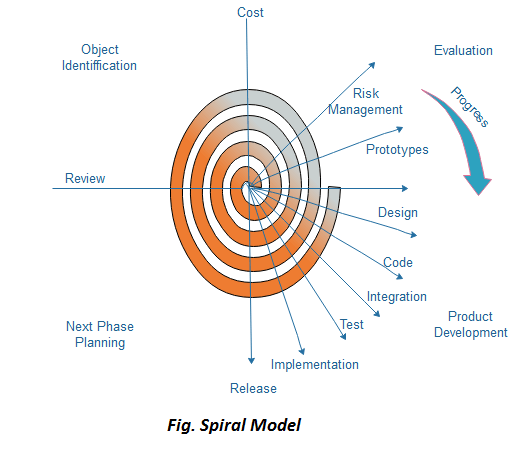Spiral Model
Spiral Model
The spiral model, initially proposed by Boehm, is an evolutionary software process model that couples the iterative feature of prototyping with the controlled and systematic aspects of the linear sequential model. It implements the potential for rapid development of new versions of the software. Using the spiral model, the software is developed in a series of incremental releases. During the early iterations, the additional release may be a paper model or prototype. During later iterations, more and more complete versions of the engineered system are produced.
The Spiral Model is shown in fig:

Each cycle in the spiral is divided into four parts:
Objective setting: Each cycle in the spiral starts with the identification of purpose for that cycle, the various alternatives that are possible for achieving the targets, and the constraints that exists.
Risk Assessment and reduction: The next phase in the cycle is to calculate these various alternatives based on the goals and constraints. The focus of evaluation in this stage is located on the risk perception for the project.
Development and validation: The next phase is to develop strategies that resolve uncertainties and risks. This process may include activities such as benchmarking, simulation, and prototyping.
Planning: Finally, the next step is planned. The project is reviewed, and a choice made whether to continue with a further period of the spiral. If it is determined to keep, plans are drawn up for the next step of the project.
The development phase depends on the remaining risks. For example, if performance or user-interface risks are treated more essential than the program development risks, the next phase may be an evolutionary development that includes developing a more detailed prototype for solving the risks.
The risk-driven feature of the spiral model allows it to accommodate any mixture of a specification-oriented, prototype-oriented, simulation-oriented, or another type of approach. An essential element of the model is that each period of the spiral is completed by a review that includes all the products developed during that cycle, including plans for the next cycle. The spiral model works for development as well as enhancement projects.
When to use Spiral Model?
- When deliverance is required to be frequent.
- When the project is large
- When requirements are unclear and complex
- When changes may require at any time
- Large and high budget projects
Advantages
- High amount of risk analysis
- Useful for large and mission-critical projects.
Disadvantages
- Can be a costly model to use.
- Risk analysis needed highly particular expertise
- Doesn't work well for smaller projects.
Comments
Post a Comment